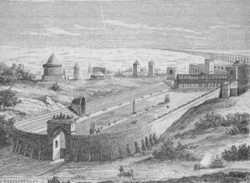Maxentius facts for kids
Quick facts for kids Maxentius |
|||||||||
|---|---|---|---|---|---|---|---|---|---|
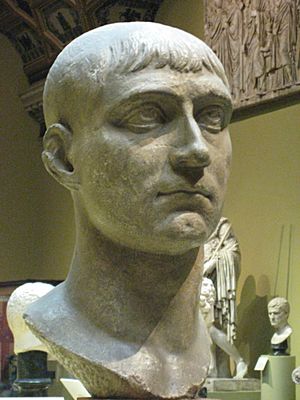
Pushkin Museum cast of original bust from Staatliche Kunstsammlungen Dresden
|
|||||||||
| Roman emperor (in Italy) | |||||||||
| Reign | 28 October 306 – 28 October 312 | ||||||||
| Predecessor | Severus II | ||||||||
| Successor | Constantine I | ||||||||
| Co-rulers |
See list
Severus II (306–307)
Galerius (East, 306–311) Maximian (306–308) Constantine I (306–312) Licinius (308–312) Maximinus II (East, 310–12) |
||||||||
| Born | c. 283 | ||||||||
| Died | 28 October 312 (aged c. 29) Rome |
||||||||
| Spouse | Valeria Maximilla | ||||||||
| Issue | Valerius Romulus and 1 other son | ||||||||
|
|||||||||
| Father | Maximian | ||||||||
| Mother | Eutropia | ||||||||
Marcus Aurelius Valerius Maxentius (born around 283 AD, died October 28, 312 AD) was a Roman emperor. He ruled from 306 until his death in 312. Maxentius controlled Italy and North Africa. The Senate in Rome recognized him as emperor. However, other emperors did not see him as a true ruler.
He was the son of a former emperor named Maximian. He was also the son-in-law of Emperor Galerius. The last years of Maxentius's rule were filled with civil war. He joined forces with Maximinus against Licinius and Constantine. Constantine defeated Maxentius at the Battle of the Milvian Bridge in 312. Maxentius's army fled, and he is believed to have drowned in the Tiber river.
Maxentius was the last emperor to live permanently in Rome. He worked to make the ancient capital more beautiful and to restore its buildings. He started many important building projects. These included the Temple of the Divine Romulus, dedicated to his son. He also began the Basilica of Maxentius, which Constantine later finished. Other projects were the villa and the circus of Maxentius.
Contents
Maxentius's Early Life and Rise to Power
Early Life and Family
Maxentius was the son of Emperor Maximian. His mother was Eutropia, who was from Syria. Since his father became emperor in 285, Maxentius was seen as a future ruler. But he did not hold any important military or government jobs. This was during the rule of Diocletian and his father. Maxentius married Valeria Maximilla, who was the daughter of Emperor Galerius. We do not know the exact date of their marriage. They had two sons. One was Valerius Romulus (who lived from about 295 to 309). The other son's name is not known.
In 305, Diocletian and Maximian gave up their power. Constantius and Galerius became the new senior emperors, called Augusti. Even though two sons of emperors, Constantine and Maxentius, were available, they were not chosen. Instead, Valerius Severus and Maximinus Daza became junior emperors, called Caesares. Some historians say that Galerius disliked Maxentius. He used his influence to make sure Maxentius was not chosen. Perhaps Diocletian also thought Maxentius was not ready for military leadership. Maxentius then moved to an estate outside Rome.
When Constantius died in 306, his son Constantine was made emperor on July 25. Galerius later accepted Constantine into the Tetrarchy as a Caesar. This event set a pattern for Maxentius's own rise to power later that year.
How Maxentius Became Emperor
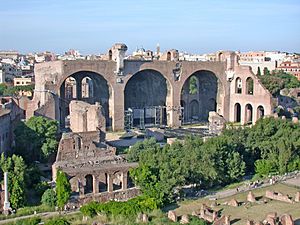
Rumors spread in Rome that the emperors planned to tax the Roman people. They also wanted to get rid of the Praetorian Guard, which was still in Rome. These rumors caused riots. A group of army officers in the city asked Maxentius to become emperor. They likely thought that since Constantine, another emperor's son, was recognized, Maxentius would be too. Maxentius agreed and promised gifts to the city's troops. He was publicly declared emperor on October 28, 306. This takeover happened mostly without violence. The city's governor joined Maxentius and kept his job. The people who planned this also asked Maximian, Maxentius's father, to return to power. He was living in a palace in Lucania, but he refused for a while.
Maxentius was recognized as emperor in central and southern Italy. He also gained control of the islands of Corsica and Sardinia, Sicily, and the African provinces. Northern Italy remained under the control of the western emperor, Valerius Severus, who lived in Mediolanum (Milan).
At first, Maxentius did not use the titles Augustus or Caesar. He called himself princeps invictus ("undefeated prince"). He hoped that Galerius, the senior emperor, would recognize his rule. But Galerius refused. Galerius probably disliked Maxentius. He also wanted to stop others from declaring themselves emperors, like Constantine and Maxentius had done. Constantine had strong control over his father's army and lands. Galerius could pretend that Constantine's rise was part of the normal system. But this was not true for Maxentius. He would be the fifth emperor, and he had few troops. Galerius thought it would be easy to stop Maxentius. So, in early 307, Emperor Severus marched on Rome with a large army.
Most of Severus's army had fought under Maxentius's father, Maximian, for many years. When Severus reached Rome, most of his soldiers switched sides to Maxentius. They received a lot of money. Maximian then left his retirement and returned to Rome to support his son. Severus and the rest of his army retreated to Ravenna. Soon after, Severus surrendered to Maximian. Maximian promised that Severus's life would be spared.
After Severus's defeat, Maxentius took control of northern Italy up to the Alps. He also gained the Istrian peninsula to the east. He then took the title of Augustus, which he felt was now available after Severus's surrender.
Maxentius as Emperor
Early Years of His Rule
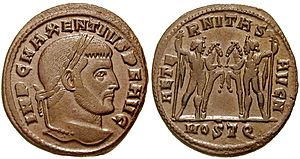
Maxentius and Maximian ruled together in Rome. Their rule was tested when Galerius marched into Italy in the summer of 307. He had an even larger army. Maxentius used the same tactic he had used against Severus. He offered large sums of money and used Maximian's authority. Many of Galerius's soldiers left his side and joined Maxentius. Galerius was forced to leave Italy, plundering towns on his way. At some point during this invasion, Maxentius had Severus killed. This likely happened near Rome. After Galerius's failed campaign, Maxentius's rule over Italy and Africa was secure.
Starting in 307, Maxentius tried to become friends with Constantine. In the summer of that year, Maximian traveled to Gaul. There, Constantine married Maximian's daughter, Fausta. In return, Maximian named Constantine an Augustus. Constantine tried not to break with Galerius. He did not openly support Maxentius during the invasion.
In 308, Maximian tried to remove his son from power. This happened at a meeting of soldiers in Rome. To Maximian's surprise, the soldiers stayed loyal to Maxentius. Maximian had to flee to Constantine. On April 20, Maxentius declared himself the new consul for the year. He named his son Romulus as co-consul. At a meeting of emperors in Carnuntum later that year, Maxentius was again not recognized as a true emperor. Licinius was appointed Augustus with the job of taking back the lands Maxentius controlled.
Late in 308, Domitius Alexander was declared emperor in Carthage. The African provinces then broke away from Maxentius's rule. This created a dangerous situation for Maxentius. Africa was very important for Rome's food supply.
Maxentius's oldest son, Valerius Romulus, died in 309. He was about fourteen years old. He was made a god (deified) and buried in a special tomb. This tomb was part of the Villa of Maxentius on the Via Appia. Maxentius also built the Circus of Maxentius nearby. After Maximian died in 309 or 310, relations with Constantine quickly worsened. Maxentius allied with Maximinus to counter the alliance between Constantine and Licinius. He reportedly tried to take control of Raetia, a province north of the Alps. This would have separated the lands of Constantine and Licinius. But this plan was not carried out because Constantine acted first.
In 310, Maxentius lost Istria to Licinius. Licinius could not continue his military campaign. By mid-310, Galerius became too ill to be involved in politics. He died soon after April 30, 311. Galerius's death made the system of shared rule (Tetrarchy) unstable. When Maximinus heard the news, he moved his army against Licinius. He took control of Asia Minor. Then he met Licinius to discuss peace terms. Meanwhile, Maxentius strengthened northern Italy against possible invasions. He sent a small army to Africa. This army, led by Rufius Volusianus, defeated and killed the rebel Domitius Alexander in 310 or 311. Maxentius used this chance to take the wealth of Alexander's supporters. He also brought large amounts of grain to Rome. He also gained more support from Christians in Italy. He allowed them to choose a new Bishop of Rome, Eusebius.
Maxentius was not very secure in his power. His early support began to turn into open protest. By 312, he was barely tolerated. Without money from the empire, Maxentius had to tax Italy again. This was to pay for his army and his building projects in Rome. Allowing a new bishop did not help much either. Diocletian's persecution had split the Italian church. Christians were divided over the issue of apostasy (giving up their faith). Christians in Italy could easily see that Constantine was more supportive of them than Maxentius.
In the summer of 311, Maxentius prepared his army against Constantine. Licinius was busy in the East. Maxentius declared war on Constantine. He swore to get revenge for his father's "murder." Constantine wanted to stop Maxentius from forming an alliance with Licinius. So, over the winter of 311–312, Constantine made his own alliance with Licinius. He offered his sister Constantia to Licinius in marriage. Maximinus Daza saw Constantine's agreement with Licinius as an insult. In response, he sent messengers to Rome. He offered to recognize Maxentius as emperor in exchange for military help. Two alliances were formed: Maximinus and Maxentius, and Constantine and Licinius. The emperors prepared for war.
War Against Constantine
Battle of Verona
Maxentius expected an attack from Licinius on his eastern side. So, he placed an army in Verona. Constantine had fewer soldiers than Maxentius. Maxentius had about 100,000 soldiers. These included troops from Africa, the Praetorian Guard, and soldiers he took from Severus. He used many of these to guard fortified towns. Most of his army stayed with him in Verona. Constantine, however, had only between 25,000 and 40,000 men. He could not remove many more troops from the Rhine borders. Against the advice of his generals, Constantine decided to attack first. He surprised Maxentius.
Battle of Turin
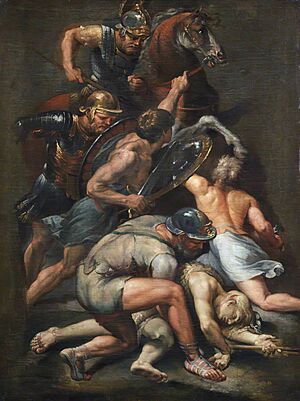
As soon as the weather allowed, in late spring 312, Constantine crossed the Alps. He took about a quarter of his army, less than 40,000 men. He crossed the Cottian Alps at the Mont Cenis pass. His first stop was Segusium (Susa, Italy). This was a strong town with soldiers, and its gates were closed to him. Constantine ordered his troops to set the gates on fire and climb the walls. He quickly took the town. Constantine did not allow his soldiers to loot the town. He then moved into northern Italy.
Near the important city of Augusta Taurinorum (Turin, Italy), Constantine met a large force of Maxentius's heavily armored cavalry. These were called clibanarii or cataphracti. In the battle that followed, Constantine spread his forces into a line. This allowed Maxentius's cavalry to ride into the middle of his army. As Constantine's forces surrounded the enemy cavalry, his own cavalry attacked the sides of Maxentius's armored horsemen. They hit them with iron-tipped clubs. Many of Maxentius's cavalrymen fell from their horses. Others were badly hurt. Constantine then ordered his foot soldiers to attack the remaining Maxentian infantry. They cut them down as they ran away. The victory, according to a writer of the time, was easy. Turin refused to let Maxentius's retreating soldiers in. Instead, it opened its gates to Constantine. Other cities in northern Italy saw Constantine's quick and kind victories. They sent him messages of congratulations. He then moved to Milan, where he was welcomed with open gates and cheers. He stayed there until mid-summer 312 before moving on.
Battle of the Milvian Bridge

People expected Maxentius to use the same strategy he had used against Severus and Galerius. This meant staying inside the well-defended city of Rome. He would wait out a siege, which would cost his enemy a lot. However, for unclear reasons, he changed this plan. He offered to fight Constantine near the Milvian Bridge on October 28, 312. Ancient writers often say this was due to superstition or divine help (if they supported Constantine). Maxentius had consulted fortune-tellers before the battle, as was common. It is likely they gave him good signs. Especially since the day of the battle was his dies imperii, the day he became emperor (October 28, 306). What else motivated him is not certain.
The armies of Maxentius and Constantine met north of the city. This was some distance outside the walls, beyond the Tiber river, on the Via Flaminia. Christian stories, especially from Lactantius and Eusebius of Caesarea, say that Constantine fought under the labarum (a Christian symbol) in that battle. They claim it was revealed to him in a dream. Not much is known about the battle itself. Constantine's forces defeated Maxentius's troops. They retreated to the Tiber river. In the chaos of his fleeing army trying to cross, Maxentius fell into the water and drowned. His body was found the next day. It was paraded through the city to show that he was truly dead. Later, it was sent to Africa. Maxentius's entire family, including his two orphaned children, were also executed.
Maxentius's Legacy
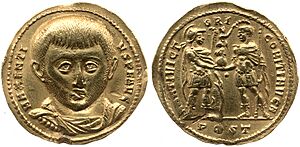
After Constantine's victory, Maxentius was made to look bad. He was described as a cruel, bloodthirsty, and bad ruler. Early sources did not list him as someone who persecuted Christians. But later Christian stories, influenced by official messages, also showed Maxentius as against Christianity. This negative image has stayed in our historical sources. It shaped how people viewed Maxentius until the 20th century.
Recent studies (from 2021 and 2022) have helped identify Maxentius's letters. These letters had been changed and even faked over time. This was done to make them fit a story that favored Constantine. By comparing these letters with Roman law and other old documents, historians have rebuilt the original texts. These original texts show that Maxentius had a policy that supported Christians. This matches what early historians like Eusebius of Caesarea and Saint Augustine reported.
According to these new documents, Maxentius ended the Great Persecution in his lands. This was at least five years before the famous Edict of Milan. The Great Persecution was the Roman Empire's last and bloodiest official persecution of Christians. It lasted from 303 to 311 in most parts of the Empire. But it ended earlier in the areas Maxentius ruled.
These documents show that Maxentius:
- Made Christianity a legal religion. He welcomed the "New Gods" into the Roman peace (Epistle 1).
- Officially ended Diocletian's persecution law (Epistle 1).
- Threatened serious punishments for anyone who continued to persecute Christians (Epistle 1).
- Acted against a Christian group called the Donatists in Africa. This showed his strong alliance with the Church of Rome (Epistle 2).
Constantine came to power in 312 after defeating Maxentius at the Milvian Bridge.
Maxentius was a very active builder. But his achievements were hidden by Constantine. Constantine ordered a damnatio memoriae against him. This meant Maxentius's name and memory were erased. Many buildings in Rome that people think Constantine built were actually started by Maxentius. An example is the great basilica in the forum Romanum.
Discovery of Imperial Symbols
In December 2006, Italian archaeologists made an exciting announcement. They were digging under a shrine near the Palatine Hill. There, they found several items in wooden boxes. They believed these were the imperial regalia, or symbols of power, possibly belonging to Maxentius. The items were wrapped in linen and what looked like silk. They included three complete spears, four javelins, a base for military standards, and three glass and chalcedony spheres.
The most important discovery was a sceptre. It looked like a flower holding a blue-green globe. Because of its detailed design, it is thought to have belonged to the Emperor himself. It has been dated to his time as ruler.
These are the only known imperial symbols ever found from that time. Before this, we only knew about them from coins and sculptures. Clementina Panella, the archaeologist who found them, said, "These artifacts clearly belonged to the emperor, especially the sceptre, which is very elaborate. It's not an item you would let someone else have." Panella believes Maxentius's supporters likely hid the symbols. They wanted to keep his memory alive after Constantine defeated him at the Battle of the Milvian Bridge. The items have been cleaned and repaired. They are now on temporary display at the Museo Nazionale Romano at the Palazzo Massimo alle Terme.
Family Tree
|
(See also: Chronological scheme of the Tetrarchy, 286–324)
|
||||||||||||||||||||||||||||||||||||||||||||||||||||||||||||||||||||||||||||||||||||||||||||||||||||||||||||||||||||||||||||||||||||||||||||||||||||||||||||||||||||||||||||||||||||||||||||||||||||||||||||||||||||||||||||||||||||||||||||||||||||||||||||||||||||||||||||||||||||||||||||||||||||||||||||||||||||||||||||||||||||||||||||||||||||||||||||||||||||||||||||||||||||||||||||||||||||||||||||||||||||||||||||||||||||||||||||||||||||||||||||||||||||||||||||||||||||||||||||||||||||||||||||||||||||||||||||||||||||||||||||||||||||||||||||||||||||||||||||||||||||||||||||||||||||||||||||||||||||||||||||||||||||||||||||||||||||||||||||||||||||||||||||||||||||||||
|
Notes: Bibliography:
|
||||||||||||||||||||||||||||||||||||||||||||||||||||||||||||||||||||||||||||||||||||||||||||||||||||||||||||||||||||||||||||||||||||||||||||||||||||||||||||||||||||||||||||||||||||||||||||||||||||||||||||||||||||||||||||||||||||||||||||||||||||||||||||||||||||||||||||||||||||||||||||||||||||||||||||||||||||||||||||||||||||||||||||||||||||||||||||||||||||||||||||||||||||||||||||||||||||||||||||||||||||||||||||||||||||||||||||||||||||||||||||||||||||||||||||||||||||||||||||||||||||||||||||||||||||||||||||||||||||||||||||||||||||||||||||||||||||||||||||||||||||||||||||||||||||||||||||||||||||||||||||||||||||||||||||||||||||||||||||||||||||||||||||||||||||||||
In Culture
- The Battle of the Milvian Bridge is a famous fresco from the 1520s. It was painted by Giulio Romano in the Apostolic Palace in the Vatican.
- Maxentius is the main bad guy in the 1961 film Constantine and the Cross. The actor Massimo Serato plays him.
- Maxentius is shown in the 5th episode of Ancient Rome: The Rise and Fall of an Empire.
- In the 2014 film Katherine of Alexandria, Maxentius was played by Julien Vialon.
See also
 In Spanish: Majencio para niños
In Spanish: Majencio para niños


